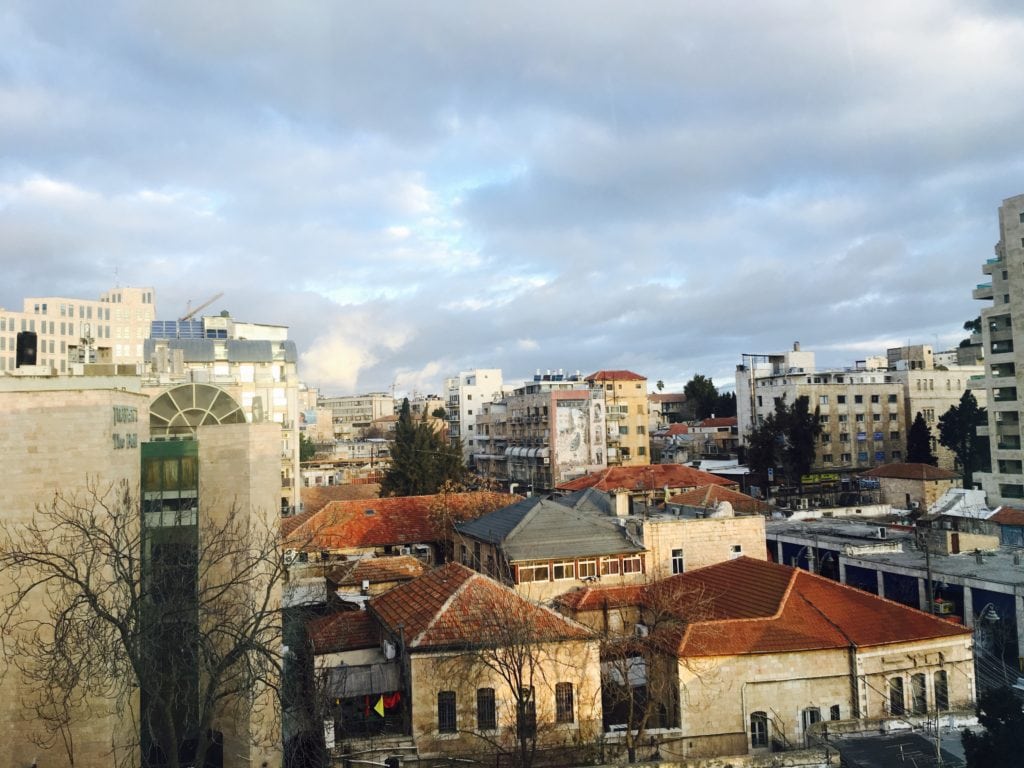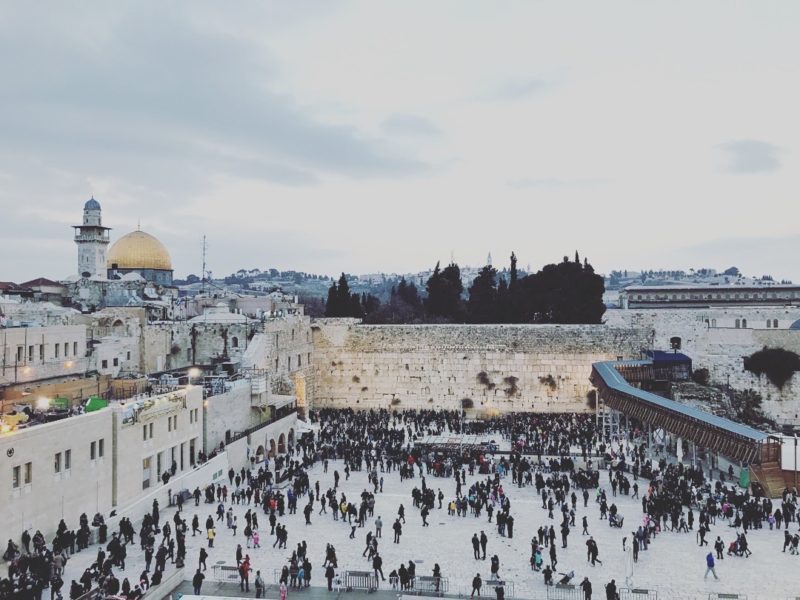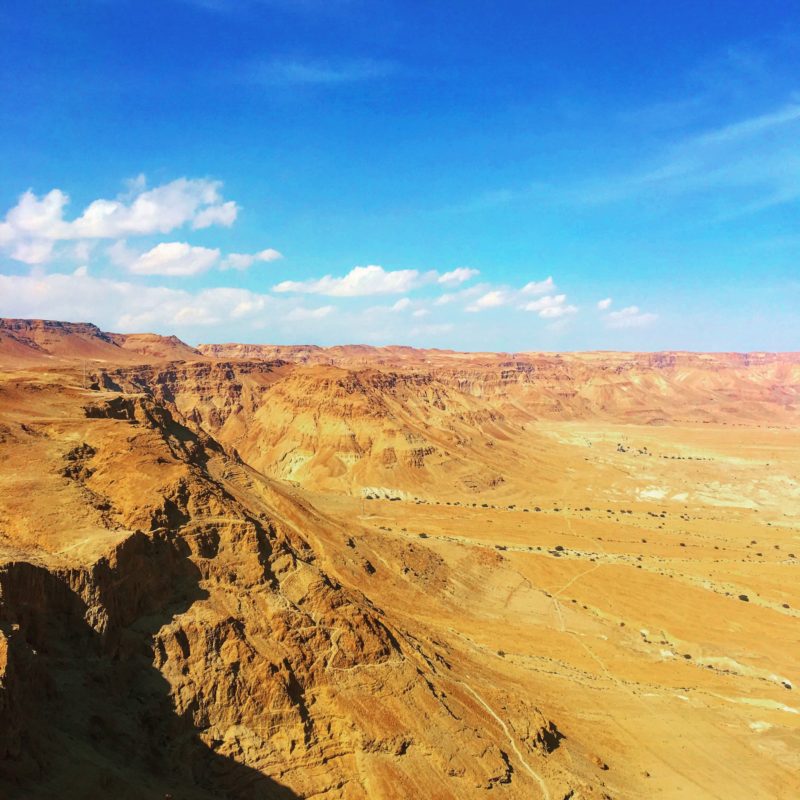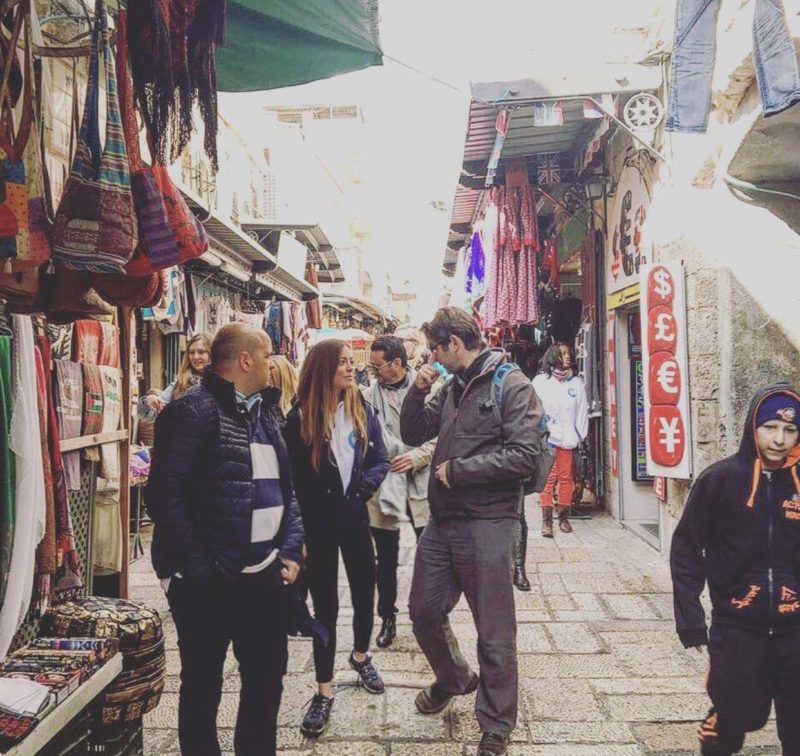Parallel Journeys Through The Holy Land: Jerusalem

Co-Written by Olivia Balsinger & Misty Foster.
In this series, two travelers from the USA–Olivia Balsinger and Misty Foster–journey through The Holy Land of Israel. The catch? Olivia traveled on a Young Travel Professionals Media Program and Misty embarked on the journey over the holidays with her boyfriend and local pals. While entirely different journeys, both returned home rejuvenated, spirited and with many a story to tell. In this guide series, they will share recommendations about where to visit, sleep and what to eat whilst meandering through Israel. As the third and final chapter of our Journey Through The Holy Land feature: Jerusalem.
Windows lit by Chanukah candles during the winter months are a magical sight to behold. The sweet smell of wildflowers and almond trees in the spring are a sensory delight. Of course, anytime of the year is wonderful to visit Jerusalem. With over 2,00 archeological sites, 60 museums, 70 cultural centers and seven gate entrances to the Old City, finding something to do in Jerusalem shouldn’t be hard. The city is as funky as it is historical.
Judaism isn’t the only religion celebrated here (though it is the most practiced.) This city is a cultural hub and Jews, Arabs, Christians and other minority sects reside here together. The Israeli-Palestine conflict is very much alive and felt within the walls, but hatred and hostility is surprisingly minuscule compared to the sense of community and pride. The people are friendly, thoughtful and want to show you why Jerusalem is their home.
Where To Eat
Tmol Shilshom: Want to eat some of the best pasta of your life? In Israel?! It can be done. Tmol Shilshom is tucked away in an upstairs building. If you didn’t know it was there, you’d miss it and be remiss. It is dually part bookstore/ library and part restaurant/performance cafe. Go for shakshuka in the morning and come back for the pumpkin gnocchi at night. The place seamlessly transitions from brunch spot, to internet cafe to romantic dinner all in one day. Did we mention the pasta? We are still drooling over it!
Hachapuria Machne Yehuda: Go to the Machane Yehuda Market when you are in Jerusalem. This Shuk is where you can taste ALL of the delights of Israel– in fact, anything from dolmas to dried nuts and spices are available here. After you’ve noshed on a few treats, walk down to HaEshkol St. and pop into Hachapuria in the Gregorian side of the Shuk. Hachapuria is a Gregorian pastry made of dough and cheese. That’s not really doing it justice! The middle portion can be filled with egg or other savory items. Once you have your first bite, you’ll be hooked.
Beer Bazaar: The Beer Bazaar doesn’t have a website yet, but they have a hoppin’ shop in the Shuk. If you ever wanted to hang out with Hasidic hipsters, this would be the place. All the beers served are local, craft beers and the vibe is spot on. You can listen to local music acts in the back room, or sit out on the sidewalk and people watch.
Shabbat of a Lifetime: Forget restaurants or room service. Keen on finding the most authentic manner of dining in Jerusalem? Enjoy as local an experience as you can get by dining with an Israeli family for the sacred meal each Friday evening after sunset known as Shabbat. Tourists of all religious beliefs and backgrounds are welcomed to the family table, learning the traditions of the Shabbat meal while indulging in five courses of delicious and authentic homemade cuisine.
Part of what makes a Shabbat meal so special is that all guests are encouraged to be in the present–making conversation, laughing and enjoying the company of old and new friends. This means that phones and electronic devices should be turned off for the length of the meal–trust us, Instagram can wait!
What To Do
Dome of the Rock: One of the most controversial and most visited sites in Jerusalem is The Dome of the Rock. This Islamic shrine holds the Foundation Stone, which is said to have been the site where Abraham attempted to sacrifice his son, Isaac.
Because of this, the stone holds significance for Muslims, Jews and Christians alike. Today, non-Muslims are allowed to visit with restricted access, but not allowed to pray. Israelis are not allowed to enter the West Bank and therefore, cannot go inside the temple. It is a great point of contention for the two religions and one that still holds great weight in the conflict between the two. If you are able to visit the holy site, be respectful and read up on the history and great significance prior.
 Stations of the Cross. Photo by: Misty Foster.
Stations of the Cross. Photo by: Misty Foster.
Church of the Holy Sepulchre: If you want to visit grounds where three major world religions come together on an incredibly important piece of land, visit The Church of the Holy Sepulchre. This has been identified as the place where Jesus was crucified and rose from the dead. Visitors can take a pilgrimage (The Way of the Cross) through the five stations of the cross and end at the Holy Sepulchre itself. Be prepared to wait in long lines to see or do anything here. Thousands of people from all backgrounds make the journey here to experience Christ’s journey and tomb.
Insider tip: If you go into the Queen Helen Coptic Church, near the 8th station, there is a hidden, underground Cistern. This vast Cistern is a great place to sing a hymn and to transport you to ancient times.
 The Western Wall. Photo by: Misty Foster.
The Western Wall. Photo by: Misty Foster.
The Western Wall (The Kotel): The most important religious place for the Jewish faith. It is considered to be holy because of it’s connection to the to the Temple Mount. It is also referred to as the “Wailing Wall”, because many Jews come to write letters to God and to weep at the site over the destruction of the Temples. It is especially stunning to visit the wall as the sun sets on the Friday night of the Sabbath–last minute prayers are heard and the city becomes tranquil and holy.
Insider Tip: Book a tour through the Kotel underground tunnels to get am archeological look at the Western Wall.
Secular Activities in Jerusalem: If you are reading this and thinking, “Gosh, this is all great, but what if I’m not religious?” The answer is, “Don’t you worry! Jerusalem has something for you!” Firstly, all of these sites can be visited under a historical or anthropological perspective. Secondly, the sheer history of this city could take days or weeks to explore and doesn’t require religious knowledge.
Yad Vashem is the one of the most comprehensive Holocaust Museums in the world (and a moving testament to the tragedy), Ein Kerem is a great neighborhood for the arts and, there’s the Jerusalem Bird Observatory for the nature lovers of the group.
Where to Stay
Arthur Hotel, Jerusalem: The Arthur Hotel in Jerusalem is a part of the prestigious Altas Hotel Group. With a delicate decor and only 54 rooms, this hotel has a sincere boutique feel to it–reflecting old world charm and some of the city’s memories frozen in photographs. But don’t get us wrong–the hotel’s amenities are entirely modern–fast WiFi, hair dryers and even a free happy hour every late afternoon. The hotel is located in one of Jerusalem’s most up-and-coming entirely pedestrian-friendly neighborhoods and within walking distance to The Old City.
Isrotel Cramim Spa & Hotel: Halfway through an engaging yet fast-paced itinerary trying to experience all that Israel offers, visitors may want to take an evening to breathe, relax and perhaps enjoy a glass of bubbly. While this may sound like a fantasy or traveler’s day dream, the newly opened Isrotel Cramim Spa & Hotel makes a night (or two..or three) of relaxation a reality.
Located in the The Jerusalem Hills, just a 20 minute drive from the city center and 40 minutes from Tel Aviv, this newly opened property is truly a paradise for families, couples and singles alike. Surrounded by villages, boutique wineries, hidden hiking trails and monasteries, there is no shortage of authentic Israeli culture for the curious traveler to learn from and enjoy.
However, should one decide to kick back and simply indulge for a bit, there will be little to “wine” about. “Cramim” actually means “vineyards” in Hebrew–quite appropriately, as most of the 156 stunning rooms showcase grand views of the sprawling land.
Not yet convinced? What about the property’s spa, taking treatments to the next level of luxury? Or an engaging wine class to brush up on your knowledge of tannins at the Wine Boutique? Or one of the rich buffet choices amongst traditional Jerusalem delicacies in Shiraz, the Main Dining Hall at Cramim? The possibilities are endless at Cramim–relax and rejuvenate and then continue onwards, ready to further explore Israel.

Who doesn’t want to take a dip into the Dead Sea? Visiting the Dead Sea is usually high on every visitors list. The sea mud has amazing exfoliating and nourishing properties for your skin. If you plan on going, try to avoid the super touristy areas and enjoy more relaxation outside of Be mindful of what you bring to the beach and leave a clean footprint behind. Don’t bring back any of the sediment.
Insider tip: They are a bit hard to find, but the Ein Sedek are a group of natural hot springs near the beach. Take a dip in the hot spring and then get into the Dead Sea for some hot and cold action. Also nearby is are natural sweetwater springs. Again, these are hard to find and you’ll likely have to ask a local where to locate them. There are families and campers who live on the beach for periods of time, so be respectful of the community when visiting.
 Visiting Masada.
Visiting Masada.
Enjoy the same view that King Herod experienced, perched over his Dream, thousands of years prior. Where once lay a kingdom, now lay sand dunes. Where human power once dominated, now Mother Nature proves her force. Where man once ruled, now lie only remnants. A physical reminder of the dual strength and fragility of humankind. Visitors can explore Masada either by foot on about an hourlong hike, or by using the gondola to get to the top. Regardless, seeing the Judean Desert fall into the horizon of The Dead Sea is a moment all visitors will cherish with great fondness. No picture will ever do the memory justice.
 Olivia walking through the Islamic Quarter.
Olivia walking through the Islamic Quarter.
Other notable places to visit in Israel:
- Tivon– a sweet, artsy township in the north
- Nazareth– Jesus’s hometown. The Church of the Annunciation. Great spot for Arabic food
- Haifa– The Bahai gardens. Largest city with Arabic and Jewish communities living together
- Akko– Historic Phoenician city with lively Arab culture
- Caesarea– Ancient site built by King Herod 2000 years ago with stunning views of the Mediterranean Coast
- Ein Hod— Artist and creative village
- Mitzpe Hayamim— unique boutique vegetarian organic hotel in Upper Galil
There are many reasons to visit the Holy Land. Israel embraces its visitors no matter your background. Whatever yours may be, go with an open mind. Let all of the culture, art and religion reveal themselves to you. Especially at a time where there are two sects of people who are in a state of conflict, the best thing you can do is be present and mindful. Take in the nature, respect the history and meet all the amazing people and culture.
Also read Parallel Journeys through the Holy Land: Tel Aviv.
